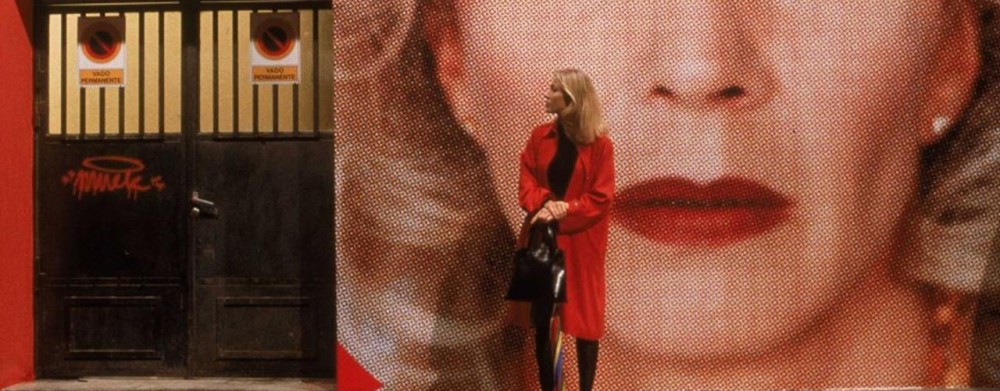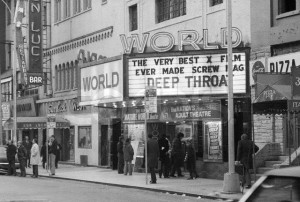In our last class I was thinking about a lot of different films, far too many to tie them together in one coherent post. Therefore this post will be a mixed bag of assorted clips, each of them relating to our Monday discussion in some way.
I mentioned Herbert Ross’s Pennies from Heaven (1981) in relation to the Tsai Ming-liang film that we watched part of, The Hole (1998). (You might want to watch the first minute of this clip first, since it’s not included in the video I embedded above and there’s dialogue that sets up the “Pennies from Heaven” number.) I realize that all musicals incorporate some level of fantasy in musical-number scenes – it is considered totally normal for characters to stop what they are doing and break into song – but what makes both Pennies from Heaven and The Hole different is that the drama in the non-musical portions of the narrative is so stark and sometimes tragic, while the musical parts are incredibly and almost overwhelmingly stylized, using vivid colors in the costumes, makeup and set design to heighten the contrast between the two types of storytelling within each film. The act of lipsynching, utilized in both films, also puts the focus on the characters’ dreams of finding some kind of paradise thanks to big-budget fantasies that temporarily ease the pain of daily life.
In thinking about uses of time in film, I find myself remembering Tsai Ming-liang’s What Time Is It There? (2001), which tells the story of a watch salesman who meets a woman for a brief moment, selling a watch to her and in the process finding out that she is moving to Paris, and this tiny slip of an encounter obsesses him so that he makes it his mission to change every timepiece so that he will always know what time it is where the woman is, in Paris. The film also makes constant reference to Truffaut’s The 400 Blows (1959), which you’ll notice in the trailer because Jean Constantin’s score for the Truffaut film plays throughout it, in addition to showing a scene from What Time Is It There? in which Lee Kang-sheng’s character watches The 400 Blows on TV. There is also a scene – perhaps a couple of scenes, I can’t quite remember – in which Jean-Pierre Léaud, the star of Truffaut’s film all those decades ago, pops up in a cameo. Besides paying tribute to that specific moment in time in cinematic history, What Time Is It There? has its own unusual sense of timing for shots, sometimes letting the camera linger, most notably in a shot of a prostitute stealing Lee Kang-sheng’s watches from his car after they have had sex (and he has fallen asleep), the shot staying fixed on the woman as she lugs the heavy case full of merchandise down the street until she is out of sight. (You can see the scene here from the 1:36:52 mark until 1:38:05.) There are also two narratives occurring simultaneously since the film tells the stories of both the watch salesman and the woman with whom he is infatuated, weaving back and forth between their individual lives in Taipei and Paris.
Ideas about time become even more complicated when dealing with documentaries. 20,000 Days on Earth (2014, dirs. Iain Forsyth and Jane Pollard) is a partly fictionalized day-in-the-life portrait of musician Nick Cave, a totally unreal setup because Cave visits so many different locations across England, France and Australia, always by car, that it makes no sense how it all could have transpired in the time frame of one sunrise to its resultant sunset. I only wish that I could find a clip online from the beginning of the film (I have the DVD – if anyone’s interested!), which organizes the chosen “important” events and memories in Nick Cave’s life into a countdown collage of moments from birth to his current day on Earth, compressed into about a minute and a half. A series of scenes throughout the film show a Nick Cave archive (designed for the film; it’s not a real place) where Cave can sift through photographs and other objects that trigger his memories à la Deleuze (moving along the y-axis, you might say…) and catalog his personal and professional histories. At the film’s climax, a Sydney Opera House concert set on that twenty-thousandth day is intercut with shots from concerts that happened throughout Cave’s career, tying memory, experience and the passage of time together as continuous influences on the world of right now. (The y-axis affects the linear progression of x-axis actions.) Every moment in the film’s one-day period is marked by the ghosts of the past.
Finally, as far as road movies are concerned, Wim Wenders’ Kings of the Road (1976) is foremost in my mind. (The original German title, Im Lauf der Zeit, translates to “In the Course of Time.”) This short clip gives you a pretty good sense of what most of the film is like: the landscape is as much a character as the humans themselves, and music fills in the space left empty by the lack of language. These two men (played by Rüdiger Vogler and Hanns Zischler), who have been thrown together by chance, often communicate through silence. They allow the environment and the soundtrack of records and radio music to speak for them. Time becomes drawn out as these characters make their way across Germany, Vogler’s projectionist character stopping his van at each town’s near-deserted and falling-apart movie theater. And given Kings’ running time of two hours and fifty-six minutes, the experience of seeing the film in a theater (as I did at MoMA last month) creates what feels like a bond between all the moviegoers, as though we had all been on a journey even though we never left our chairs. The passage of time is a constant concern in Wenders’ films, as in the thirteen-minute phone scene between Harry Dean Stanton and Nastassja Kinski in Paris, Texas (1984), which recounts the entire history of their marriage, and in the angels and humans considering the meaning of mortal existence in Wings of Desire (1987) and Faraway, So Close! (1993). Perhaps time doesn’t heal enough, as Wings’ female protagonist, Marion, wonders; maybe time is the disease. (And while we’re thinking about Wings of Desire, I also like this bit of analysis from a Criterion Collection essay on the film, which connects to readings from past classes regarding objectification, voyeurism and visual pleasure.)



